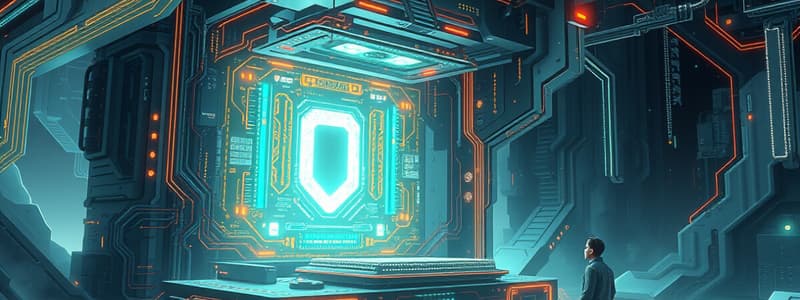Podcast
Questions and Answers
Which operation type refers to transferring data from one peripheral to another?
Which operation type refers to transferring data from one peripheral to another?
- Data storage
- Data processing
- Data movement (correct)
- Data computation
What role does the control unit play in the computer's structure?
What role does the control unit play in the computer's structure?
- It oversees the operation of the CPU. (correct)
- It manages the movement of data within the computer.
- It provides temporary data storage.
- It directly performs data calculations.
In which type of operation is data read from external storage to main memory?
In which type of operation is data read from external storage to main memory?
- Data transmission
- Data storage (correct)
- Data processing
- Data movement
Which structural component of a computer is responsible for executing logical operations?
Which structural component of a computer is responsible for executing logical operations?
What is the primary function of the system interconnections in a computer?
What is the primary function of the system interconnections in a computer?
What is primarily concerned with the connection and arrangement of hardware components in a computer system?
What is primarily concerned with the connection and arrangement of hardware components in a computer system?
Which of the following best describes the relationship between Computer Architecture and Computer Organization?
Which of the following best describes the relationship between Computer Architecture and Computer Organization?
What does Computer Organization express in relation to a computer system?
What does Computer Organization express in relation to a computer system?
Which function is NOT classified under the essential functions of a computer as described in the content?
Which function is NOT classified under the essential functions of a computer as described in the content?
What aspect do both Computer Architecture and Computer Organization share?
What aspect do both Computer Architecture and Computer Organization share?
Flashcards are hidden until you start studying
Study Notes
Differences between Computer Architecture and Organization
- Computer Architecture focuses on the high-level design and structure of hardware components and their interconnections, influencing system functionality.
- Computer Organization is concerned with the physical arrangement and operational aspects of a computer system as perceived by the user, acting as the hardware-software interface.
- Architectural elements include instruction sets, addressing modes, and data types, while organizational elements encompass circuit designs and peripherals.
- Architecture considerations precede organization when designing a computer system.
Structure and Function of Computers
- A hierarchical system consists of interrelated subsystems structured until reaching basic elemental subsystems.
- Structure denotes how components interrelate, whereas Function describes the operations of these components.
- Core computer functions include:
- Data Processing: Ability to handle various data forms through different processing ranges.
- Data Storage: Temporary or permanent data storage capabilities.
- Data Movement: Transfer of data between the computer and external entities.
- Control: Regulation of the aforementioned functions.
Main Structural Components of a Computer
- Central Processing Unit (CPU): The core element controlling operations and processing data.
- Main Memory: Responsible for data storage.
- Input/Output (I/O): Facilitates data movement between the computer and the outside environment.
- System Interconnections: Allows communication among the CPU, memory, and I/O devices.
CPU Structural Components
- Control Unit: Oversees and coordinates CPU operation.
- Arithmetic Logic Unit (ALU): Executes data processing tasks.
- Registers: Provide internal storage within the CPU.
- CPU Interconnections: Mechanisms for communication among control units, ALUs, and registers.
General System Architecture
- Memory Unit: Consists of storage cells and associated circuits for information transfer, storing data in word groups.
- Buses: Enable information sharing among registers:
- Address Bus: Carries addresses (not data) between the processor and memory.
- Data Bus: Transports data between the processor, memory, and I/O devices.
- Control Bus: Transfers command signals from the CPU.
General Purpose Systems
- Represents a modern version of the Von-Neumann Architecture, integrating CPU, memory, and I/O subsystems interconnected via a system bus.
Parallel Processing
- A technique allowing simultaneous execution of data-processing tasks to boost computational speed.
- Enhances throughput by distributing data among multiple functional units.
- Example functional units include:
- Adders and integer multipliers for arithmetic operations.
- Floating-point operations managed by dedicated circuits.
- Concurrent execution of logic, shift, and increment operations.
Flynn's Classification of Computers
- Designed by M.J. Flynn, classifies computer systems based on simultaneous manipulation of instructions and data.
- The instruction stream involves the flow of instructions from memory, while the data stream involves operations performed on data.
- Categories include:
- Single Instruction Stream, Single Data Stream (SISD): A single computer system executing instructions sequentially; may possess internal parallel processing capabilities.
Studying That Suits You
Use AI to generate personalized quizzes and flashcards to suit your learning preferences.



